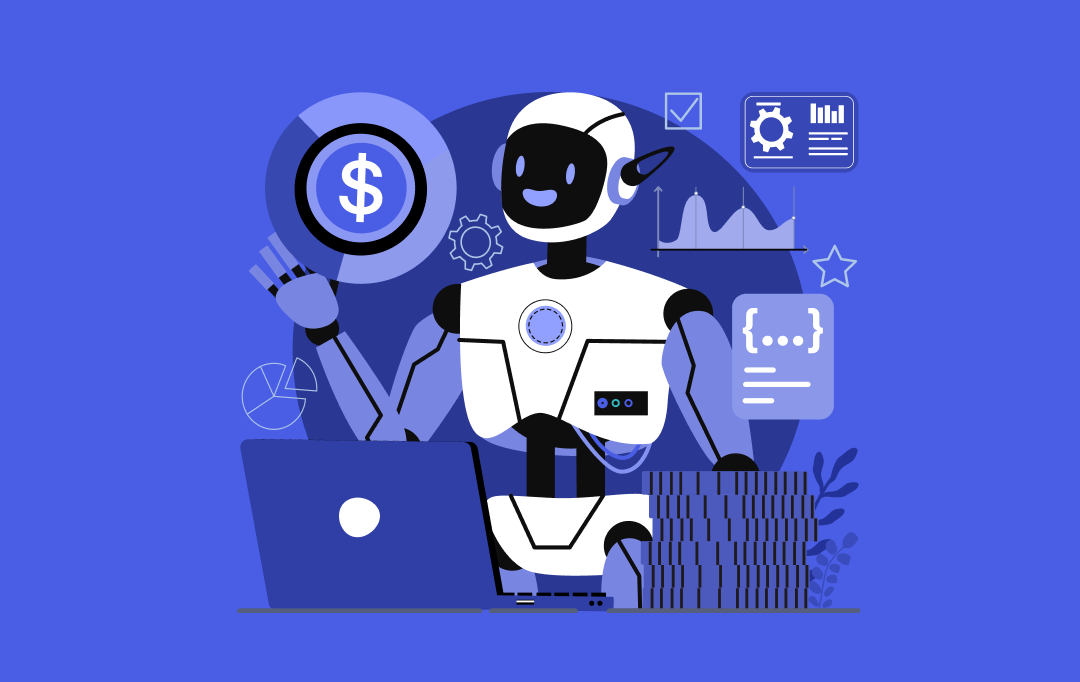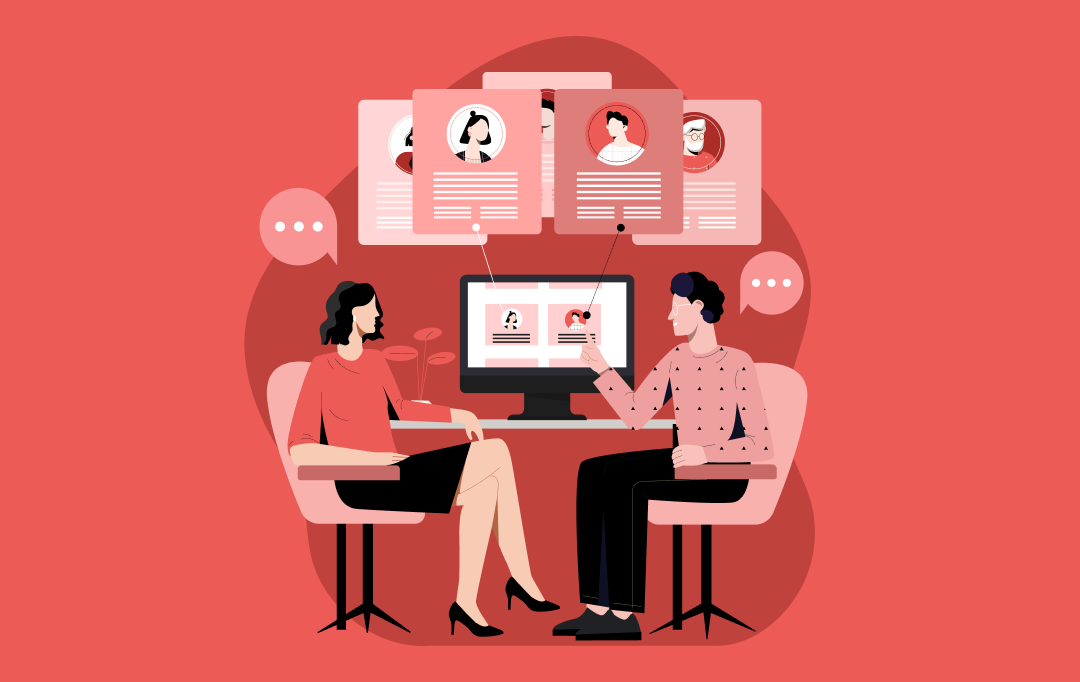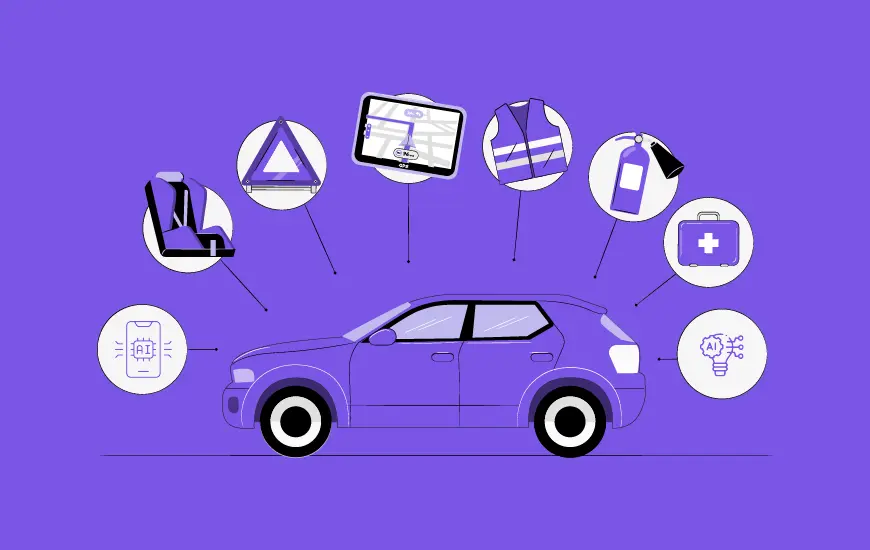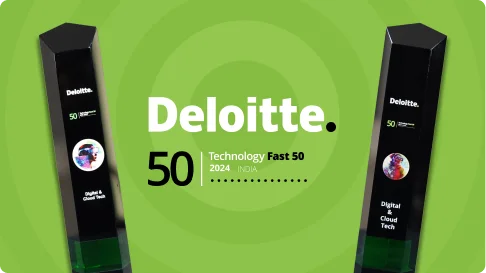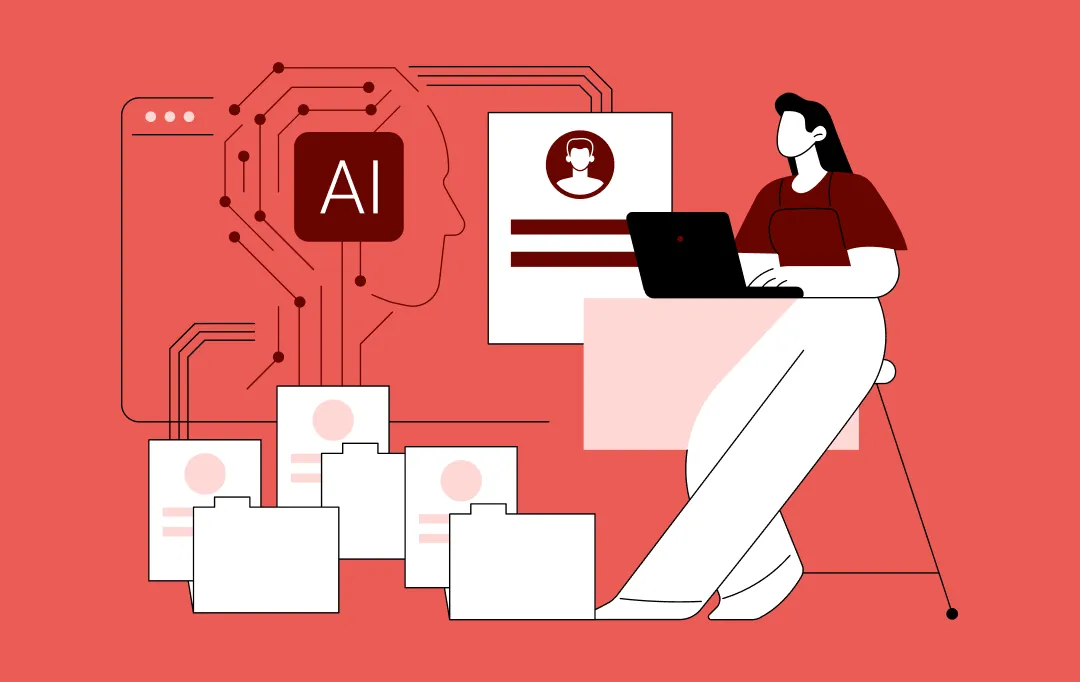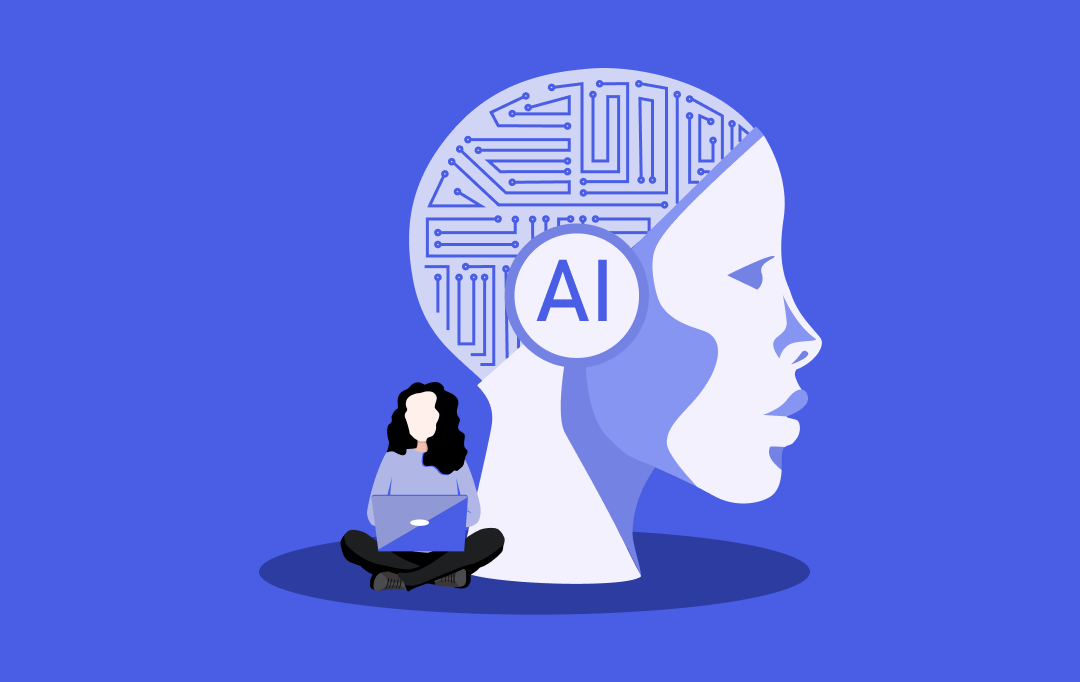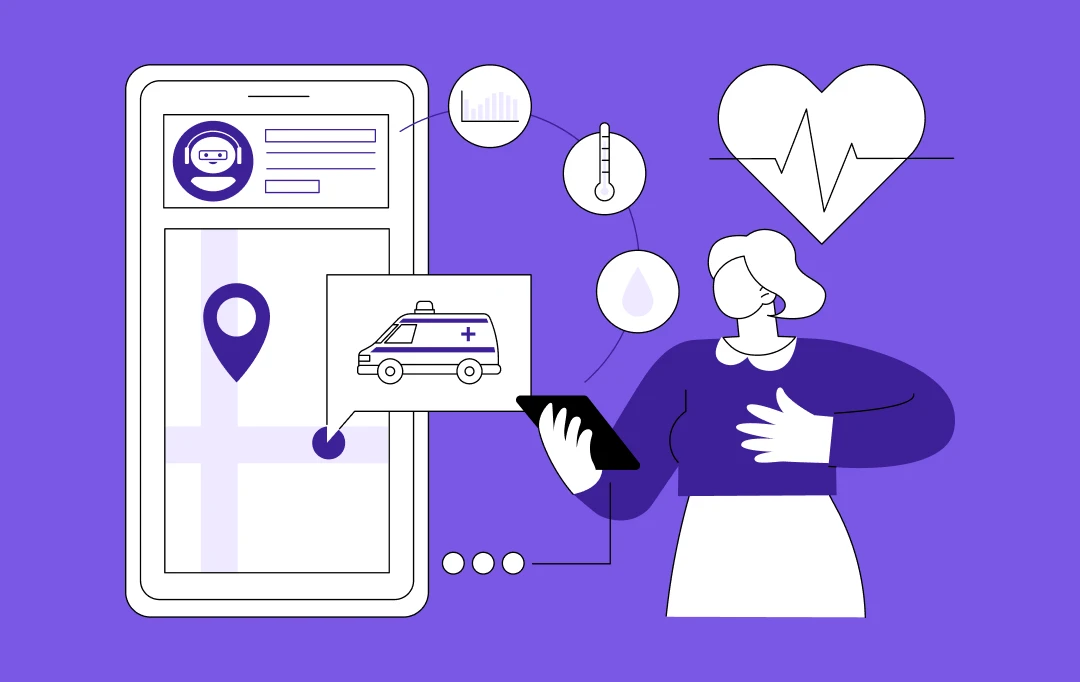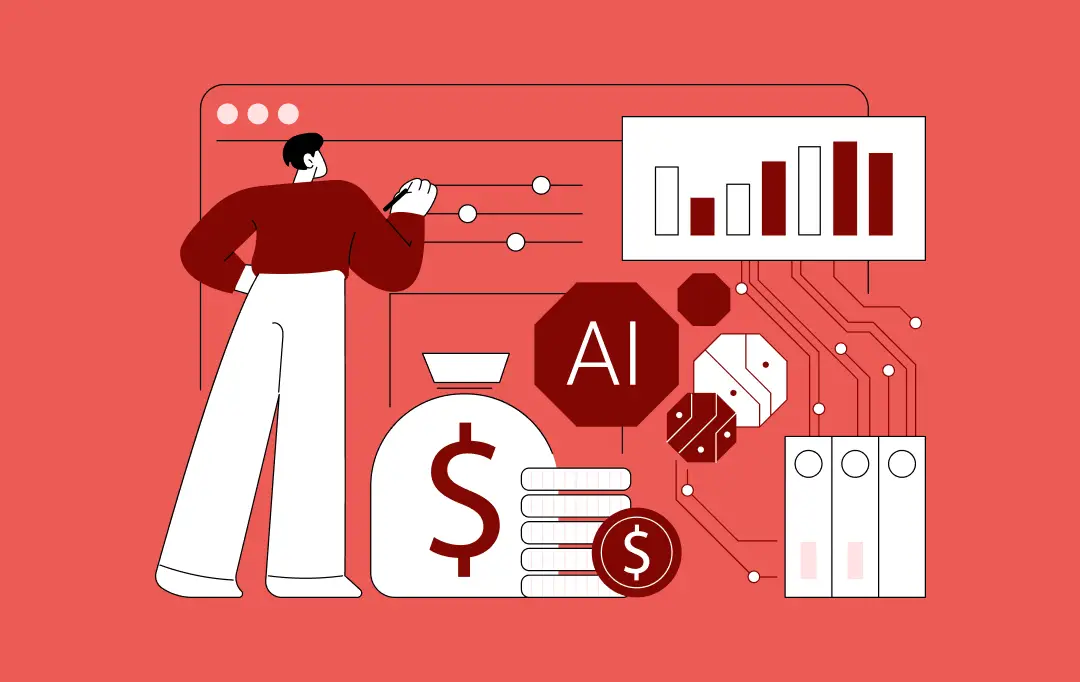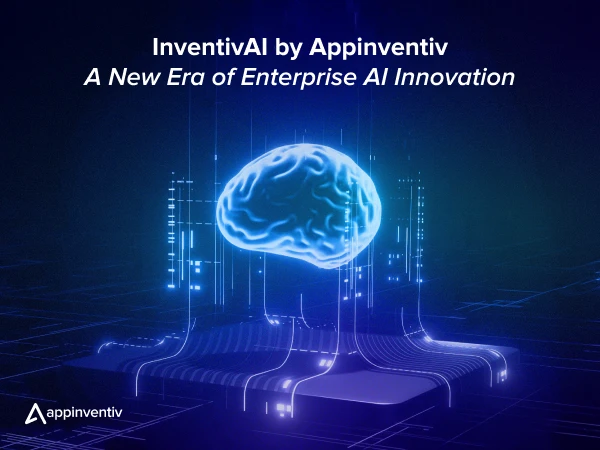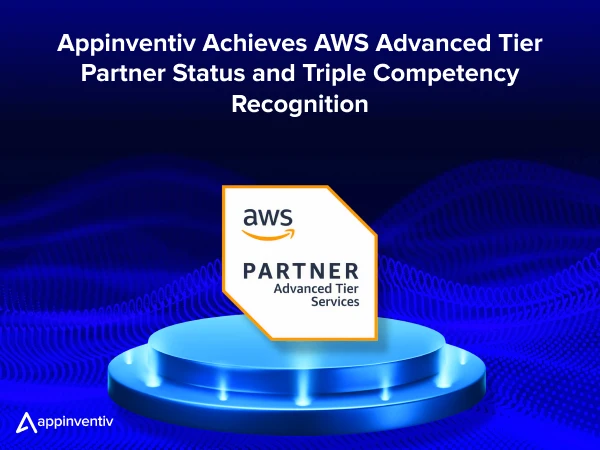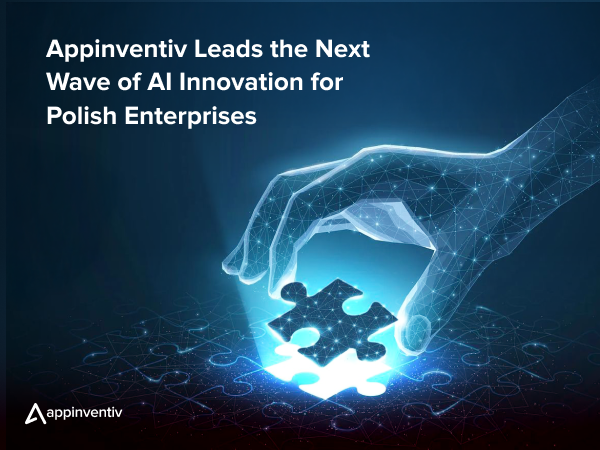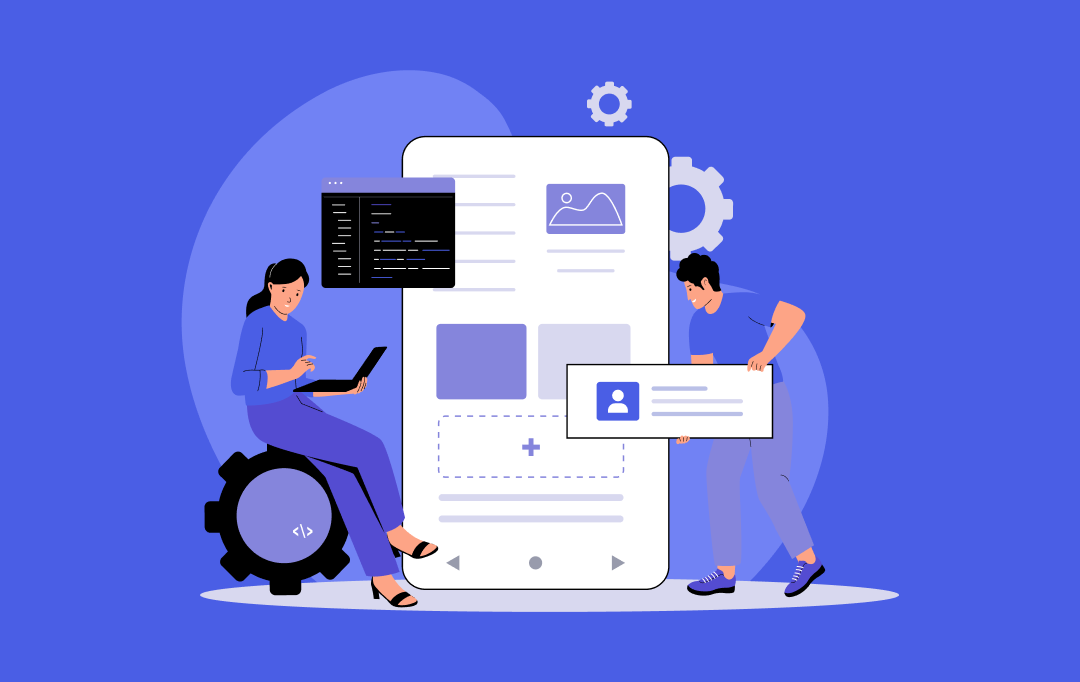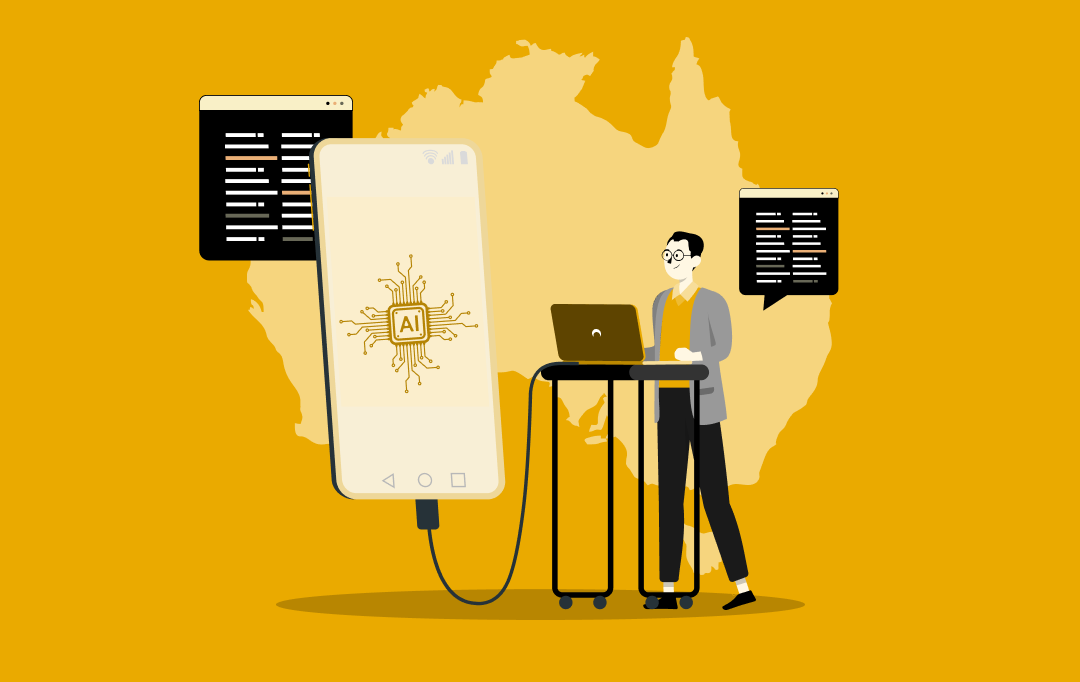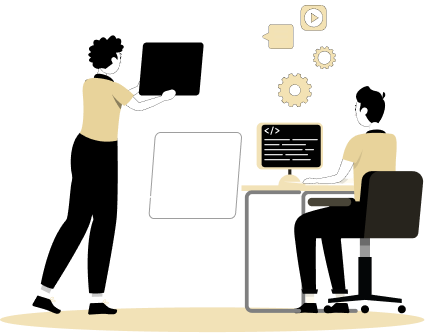- A Synopsis of the Australian AI App Market
- Cost of Technology-Wise AI App Development
- Key Cost Influencers Across AI Technologies
- Cost of Developing an AI App Based on Project Complexity
- Key Factors Driving Costs at Different Complexity Levels
- Cost of Industry-Wise AI App Development
- How Industry Influences AI App Costs
- Cost of Building an AI App Based on Features
- Development Phase-Wise Cost Breakdown of AI Apps
- Cost of Making an AI App Based on Scale of Work
- Which Engagement Model Is Right for You?
- Cost of Making an AI App Based on Resources
- How to Reduce the Costs of AI -Powered App Development without Compromising Quality
- Appinventiv’s Approach of Smart Cost Planning Without Compromising AI Excellence
- FAQs
Key takeaways:
- Begin with a clear vision and a well-defined roadmap to align your AI app development with business objectives.
- The cost of developing an AI app in Australia ranges from $33,000 to $1,000,000 or more.
- Develop a Minimum Viable Product (MVP) to test core functionalities and gather user feedback before full-scale development.
- Stay informed about Australia’s AI regulations to ensure your app adheres to legal and ethical standards.
AI is changing the way businesses operate – enhancing customer experiences, automating workflows, and unlocking insights that were once impossible to gather. AI adoption in Australia is accelerating across industries; companies aren’t just using AI; they’re contributing to the country’s economy by defining AI-powered app development in Australia.
If you’re considering developing an AI app, the opportunity is massive. The nation’s government is actively funding AI research, businesses are investing in automation, and consumer expectations for AI-driven experiences are rising. But while the potential is clear, one of the biggest challenges remains: how much does AI app development cost in Australia?
Well, the fact is that the cost to build an AI-powered app in Australia cannot be a fixed number unless every intricate detail of the project is clear, including, the complexity of the AI model, data processing needs, infrastructure, and compliance with Australia’s strict data regulations. Still, to give you a rough cost estimate, the range can vary from $33,000 – $800,000 (AUD 52,000 – AUD 1,200,000).
In this article, we’ll break down the key cost drivers, helping you navigate the financial aspects of AI development to make informed decisions.
Get a clear cost breakdown along with expert guidance at every step on the way.
A Synopsis of the Australian AI App Market
Australia is rapidly emerging as a hub for AI innovation, driven by a combination of strong government support, a skilled workforce, and increasing consumer trust in AI-powered solutions. Businesses across industries, from healthcare and finance to retail and manufacturing, are integrating AI to enhance efficiency, improve personalization, and drive smarter decision-making.
With AI becoming a core part of operations, the demand to locally build an AI-powered app in Australia is rising, creating a lucrative opportunity for entrepreneurs looking to enter the space.

One of the biggest benefits of AI app development in Australia is the favorable business environment, shaped by government-backed AI research, funding initiatives, and a regulatory framework that encourages responsible development of AI apps. The country’s highly educated, multicultural workforce adds to its appeal, offering access to diverse expertise essential for AI model training, development, and deployment.
However, businesses must also operate within Australia’s strict data privacy laws, which, while ensuring ethical AI use, add layers of complexity to development, especially for apps handling sensitive user data.
At the same time, Australian consumers are becoming increasingly comfortable with AI-driven experiences, embracing AI-powered customer service, intelligent automation, and hyper-personalized recommendations as part of their daily interactions.
With a strong economy, rising AI adoption, and a business-friendly ecosystem, the country presents an ideal landscape to create an AI app in Australia. However, success in this space requires more than just a great idea – it demands a clear understanding of the financial, technical, and regulatory challenges that shape AI innovation in the country.
Also Read: Digital Transformation Strategy for Australian Enterprises: A Practical Roadmap
Cost of Technology-Wise AI App Development
The cost to make an AI app in Australia varies significantly based on the underlying technology. Below is a breakdown of estimated development costs for different AI technologies, specific to the Australian market rates.
Computer Vision ($70,000 – $300,000 AUD | $45,000 – $200,000 USD)
Computer vision applications, such as facial recognition, defect detection, or medical imaging analysis, require high-end GPUs, extensive labeled datasets, and deep learning models. The cost of developing an AI-powered app in Australia would depend on the complexity – basic image recognition solutions are on the lower end, whereas advanced object detection or real-time video analysis can push costs higher due to an increased computational and storage demands.
Machine Learning ($80,000 – $400,000 AUD | $50,000 – $260,000 USD)
Machine learning applications range from predictive analytics to recommendation systems and fraud detection tools. The cost to develop an AI app would vary based on data availability, training time, model complexity, and the level of real-time processing required. A simple ML-powered predictive model may be on the lower end, but deep learning-based applications requiring extensive training data and cloud infrastructure can be significantly more expensive.
Natural Language Processing ($90,000 – $500,000 AUD | $60,000 – $330,000 USD)
NLP applications, such as chatbots, speech-to-text, and AI-driven content analysis, require extensive training on large language datasets. Costs increase according to the features of an AI powered app in Australia, which usually range from supporting multiple languages, requiring real-time processing, or involving complex sentiment analysis and contextual understanding.
Enterprise-grade NLP models with industry-specific training datasets typically fall on the higher end of the spectrum.
Robotics & Autonomous Systems ($150,000 – $800,000 AUD | $100,000 – $530,000 USD)
AI-driven robotics applications, including autonomous drones, robotic arms, and warehouse automation systems, involve both hardware and software development. The cost of AI-powered app development in Australia include AI model training, sensor integration, real-time decision-making capabilities, and robotic movement optimization.
Advanced applications, such as self-navigating robots or collaborative robotics (cobots) for industrial use, require specialized hardware, pushing development costs higher further.
Autonomous Technology ($200,000 – $1,200,000 AUD | $130,000 – $800,000 USD)
Autonomous AI solutions, such as self-driving vehicle software, automated surveillance systems, and AI-powered traffic management, demand high precision, safety compliance, and real-time adaptability. These applications require massive amounts of sensor data, real-time AI decision-making, and regulatory approvals, making them one of the most expensive categories to develop an AI app.
Generative AI ($120,000 – $600,000 AUD | $80,000 – $400,000 USD)
Generative AI applications, such as AI-powered content creation, synthetic media, and AI-generated art/music, rely on deep learning models like GANs (Generative Adversarial Networks) or transformer-based architectures (e.g., GPT, Stable Diffusion).
The development cost of an AI app in Australia can increase based on the level of customization, scalability, and computing power required. Custom-trained generative AI models for niche industries, such as legal document drafting or AI-driven video generation, typically fall into the higher cost range.
| AI Technologies | AI App Development Costs (AUD) | AI App Development Costs (USD) |
|---|---|---|
| Computer Vision | $70,000 – $300,000 | $45,000 – $200,000 |
| Machine Learning | $80,000 – $400,000 | $50,000 – $260,000 |
| Natural Language Processing | $90,000 – $500,000 | $60,000 – $330,000 |
| Robotics & Autonomous Systems | $150,000 – $800,000 | $100,000 – $530,000 |
| Autonomous Technology | $200,000 – $1,200,000 | $130,000 – $800,000 |
| Generative AI | $120,000 – $600,000 | $80,000 – $400,000 |
Key Cost Influencers Across AI Technologies
Regardless of the technology, certain factors heavily influence the cost to build an AI-powered app in Australia:
- Data Processing & Model Training: Training AI models on large datasets requires cloud computing resources, high-performance GPUs, and extensive fine-tuning, all of which add to development costs.
- Regulatory Compliance: Australia has strict data privacy laws (e.g., Privacy Act 1988, Consumer Data Right regulations), making compliance a crucial (and costly) factor for AI solutions handling sensitive information.
- Cloud vs. On-Premise Infrastructure: AI apps that rely on cloud platforms like AWS, Google Cloud, or Microsoft Azure typically involve subscription and usage-based costs, while on-premise AI solutions require heavy upfront investment in servers and computational power.
- Customization & Scalability: Off-the-shelf AI models (e.g., GPT-based APIs) reduce initial development costs but limit customization. In contrast, building a proprietary AI model from scratch requires specialized expertise and higher investment.
Understanding these cost drivers that directly impact the process to build an AI-powered app in Australia can help businesses with budgeting effectively and choosing the right AI technology to base their product on.
Cost of Developing an AI App Based on Project Complexity
Beyond technology choice, app complexity also plays a crucial role in determining the cost to create an AI app in Australia.
When we talk about complexity, the general rule of thumb says that the more sophisticated set of features of an AI-powered app in Australia you opt for, whether it is in terms of data processing, AI model customization, real-time decision-making, or user interactions, the higher the cost. Below is a cost breakdown based on complexity levels.
Basic AI Apps ($50,000 – $150,000 AUD | $33,000 – $100,000 USD)
These applications use pre-trained AI models and minimal customization, making them the most affordable option for startups operating on a tight budget. This app category typically include:
- Simple chatbots for customer support (e.g., FAQ bots using NLP).
- Basic recommendation engines (e.g., product suggestions based on past purchases).
- AI-driven automation tools (e.g., invoice scanning, email categorization).
- Sentiment analysis tools with limited datasets.
Such apps require minimal model training and are often built using third-party AI services (e.g., OpenAI’s API, Google AI, or AWS AI), keeping development and infrastructure costs low.
Mid-Complexity AI Apps ($150,000 – $400,000 AUD | $100,000 – $260,000 USD)
These applications involve moderate customization, larger datasets, and advanced AI capabilities. The segment typically include:
- Conversational AI bots with contextual understanding.
- Predictive analytics platforms for business insights.
- Computer vision apps (e.g., quality control in manufacturing).
- AI-driven process automation (e.g., fraud detection in banking).
At this level, AI models would require custom training, leading to an increased infrastructure cost due to higher computational needs. Additionally, integration with enterprise systems, APIs, and cloud platforms can add to the complexity and the cost to make an AI app in Australia.
Advanced AI Apps ($400,000 – $1,500,000+ AUD | $260,000 – $1,000,000+ USD)
High-end AI applications involve deep learning, multi-model AI systems, and real-time decision-making capabilities, requiring significant computing power, cloud resources, and regulatory compliance. These include:
- AI-powered medical diagnosis tools using deep learning.
- Self-learning AI models that improve with usage.
- Autonomous AI systems (e.g., self-driving software, AI-driven trading).
- Multimodal AI applications combining text, image, and voice recognition.
Such apps demand large-scale data processing, high-end GPUs, rigorous testing, and continuous monitoring, driving up both development and maintenance costs.
A fully customized AI solution requires specialized expertise and higher investment, which is why startups and enterprises often look for AI consulting agencies in Australia to ensure success.
| App Complexity Levels | AI App Development Costs (AUD) | AI App Development Costs (USD) |
|---|---|---|
| Basic AI Apps | $50,000 – $150,000 | $33,000 – $100,000 |
| Mid-Complexity AI Apps | $150,000 – $400,000 | $100,000 – $260,000 |
| Advanced AI Apps | $400,000 – $1,500,000+ | $260,000 – $1,000,000+ |
Key Factors Driving Costs at Different Complexity Levels
- Custom Model Development: More complex AI apps need custom-built models, as opposed to off-the-shelf AI solutions, significantly increasing costs.
- Data Collection & Processing: Training AI models requires clean, high-quality data, which may involve purchasing datasets, data annotation, or real-time data streaming.
- AI Infrastructure & Scalability: High-end AI apps need dedicated cloud infrastructure, GPUs, and large-scale deployment strategies.
- Compliance & Security: More complex apps, especially in finance, healthcare, or defense, require strict regulatory compliance (e.g., Australia’s Privacy Act, GDPR for global use), increasing costs.
While complexity influences the cost of developing an AI-powered app in Australia, strategies like optimizing development approaches, leveraging cloud AI services, and adopting an MVP-first approach can help businesses manage expenses effectively.
Cost of Industry-Wise AI App Development
The cost to develop an AI app in Australia varies significantly based on the industry it serves. Different sectors have unique requirements, such as compliance regulations, data privacy needs, real-time processing, and integration with existing systems, all of which impact the development costs. Below is a high-level idea of the industry-wise cost breakdown.
Healthcare & MedTech ($79,000 – $1,500,000+ AUD | $50,000 – $1,000,000+ USD)
AI applications in healthcare require high accuracy, regulatory compliance (TGA, HIPAA, GDPR), and complex AI models trained on medical data. Costs here depend on:
- AI-powered diagnostics (e.g., medical imaging analysis, predictive disease modeling).
- Virtual health assistants and AI-driven patient triage systems.
- Personalized treatment plans using AI-based genomics.
- AI-assisted robotic surgery software.
- Strict security measures to protect patient data.
Since data security and compliance add significant costs to the process, MedTech AI apps often fall into the higher price range.
Finance & Banking ($71,000 – $800,000 AUD | $45,000 – $530,000 USD)
The financial sector across Australia extensively uses AI and ML for fraud detection, risk assessment, and algorithmic trading, requiring real-time data processing, compliance with banking regulations (APRA, ASIC), and secure architecture. Costs here would depend on several features of an AI-powered app in Australia.
- AI-powered fraud detection and AML (Anti-Money Laundering) systems.
- Automated loan underwriting and credit scoring AI.
- Algorithmic trading platforms requiring split-second decision-making.
- Conversational AI assistants for customer service in banking apps.
- AI-driven financial forecasting models.
Security, real-time accuracy, and seamless banking system integration can drive up the costs further.
Retail & ECommerce ($63,000 – $500,000 AUD | $40,000 – $330,000 USD)
Retail AI applications focus on enhancing customer experience, personalizing recommendations, and optimizing supply chains. Costs vary based on:
- AI/ML-powered product recommendation engines (e.g., personalized shopping).
- Inventory forecasting and demand planning AI.
- AI chatbots for customer service.
- AI-driven dynamic pricing models adjusting prices based on demand.
- Visual search technology (e.g., searching products using images).
Manufacturing & Industry 4.0 ($79,000 – $1,200,000 AUD | $50,000 – $800,000 USD)
AI in manufacturing industry plays a critical role in industrial automation, predictive maintenance, and quality control, requiring integration with IoT devices, real-time analytics, and deep learning models. Costs here depend on:
- AI-driven predictive maintenance to reduce equipment downtime.
- Computer vision for defect detection in production lines.
- AI-powered robotics and automation for smart factories.
- Supply chain optimization using AI-driven forecasting.
Real-time AI processing and hardware integration with factory systems tend to make these solutions more expensive.
Logistics & Transportation ($79,000 – $900,000 AUD | $50,000 – $600,000 USD)
Embracing AI in logistics and transport requires exploring several logistics advantages, such as real-time route optimization, predictive analytics, and automation for fleet management. Costs typically depend on:
- AI-based route optimization for delivery and fleet management.
- Autonomous vehicle AI (self-driving software, smart traffic management).
- AI-powered demand forecasting for supply chain logistics.
- AI-driven warehouse automation (robotic sorting, smart inventory tracking).
Legal & Compliance Tech ($71,000 – $400,000 AUD | $45,000 – $260,000 USD)
AI in the legal sector focuses on automating contract analysis, legal research, and compliance monitoring, reducing manual work. Costs depend on:
- AI-powered contract review and legal document automation.
- Regulatory compliance monitoring AI (GDPR, Australian Consumer Law).
- AI-driven legal research assistants for case law analysis.
The costs of developing an AI app are driven by NLP accuracy, legal data training, and compliance with regulatory standards.
Education & EdTech ($63,000 – $600,000 AUD | $40,000 – $400,000 USD)
AI in education enhances personalized learning, automated assessments, and AI-driven tutoring. The AI-powered app development in Australia costs vary based on:
- Adaptive learning AI platforms that personalize lessons.
- AI-powered grading and assessment automation.
- Conversational AI tutors and chatbot assistants for students.
- AI-driven student performance analytics.
Higher costs usually come from the integration of custom AI training on educational content, NLP-based tutoring, and scalability.
| Industries | AI App Development Costs (AUD) | AI App Development Costs (USD) |
|---|---|---|
| Healthcare & MedTech | $79,000 – $1,500,000+ | $50,000 – $1,000,000+ |
| Finance & Banking | $71,000 – $800,000 | $45,000 – $530,000 |
| Retail & ECommerce | $63,000 – $500,000 | $40,000 – $330,000 |
| Manufacturing & Industry 4.0 | $79,000 – $1,200,000 | $50,000 – $800,000 |
| Logistics & Transportation | $79,000 – $900,000 | $50,000 – $600,000 |
| Legal & Compliance Tech | $71,000 – $400,000 | $45,000 – $260,000 |
| Education & EdTech | $63,000 – $600,000 | $40,000 – $400,000 |
How Industry Influences AI App Costs
- Data Sensitivity & Compliance: Healthcare, finance, and legal AI apps have strict regulatory requirements, increasing development, security, and legal compliance costs.
- Computational Needs: AI solutions for manufacturing, logistics, and autonomous vehicles require high-end GPU clusters, edge computing, and IoT integration, making them more expensive.
- Real-Time vs. Batch Processing: Financial trading, fraud detection, and logistics AI require instant decision-making, leading to higher cloud computing and infrastructure costs.
- Scalability & User Load: AI apps in retail, education, and customer service need scalable cloud AI infrastructure, influencing pricing.
By understanding how industry-specific requirements impact the cost of building an AI app in Australia, businesses can plan their AI investments strategically.
Cost of Building an AI App Based on Features
The cost of making an AI app is heavily influenced by the features and functionalities integrated into the application. Some AI-powered features require basic algorithm implementations, while others demand extensive data processing, deep learning models, and real-time execution, which significantly increases costs.
Below is a detailed breakdown of AI app development costs based on specific features:
AI Chatbots & Virtual Assistants – AUD 30,000 – AUD 100,000 ($20,000 – $67,000)
AI-powered chatbots are widely used in customer support, healthcare, and financial services.
- Basic rule-based chatbots (predefined responses, minimal NLP): AUD 30,000 – AUD 50,000 ($20,000 – $34,000)
- Advanced NLP-based assistants (sentiment analysis, multi-language support): AUD 50,000 – AUD 100,000 ($34,000 – $67,000)
- Voice-enabled AI assistants (Siri/Alexa-like capabilities): AUD 100,000+ ($67,000+)
Machine Learning-Based Recommendations – AUD 50,000 – AUD 150,000 ($33,000 – $100,000)
Used in eCommerce, streaming platforms, and financial services, recommendation engines analyze user behavior and provide personalized content or product suggestions.
- Simple recommendation systems (based on user preferences): AUD 50,000 – AUD 80,000 ($33,000 – $54,000)
- Advanced ML-powered recommendations (real-time behavioral analysis): AUD 80,000 – AUD 150,000 ($54,000 – $100,000)
Predictive Analytics & Forecasting – AUD 70,000 – AUD 200,000 ($47,000 – $134,000)
Predictive analytics uses AI models to forecast trends, risks, and demand in industries like healthcare, finance, and logistics.
- Basic predictive models (historical data analysis, standard ML techniques): AUD 70,000 – AUD 120,000 ($47,000 – $80,000)
- Complex predictive analytics solutions (real-time forecasting, deep learning models): AUD 120,000 – AUD 200,000 ($80,000 – $134,000)
Computer Vision (Image/Video Processing) – AUD 80,000 – AUD 250,000 ($54,000 – $167,000)
AI-driven image and video recognition is used in security, healthcare, manufacturing, and retail.
- Basic image recognition (barcode scanning, object detection): AUD 80,000 – AUD 150,000 ($54,000 – $100,000)
- Advanced computer vision (facial recognition, medical image analysis): AUD 150,000 – AUD 250,000 ($100,000 – $167,000)
Speech Recognition & Voice Processing – AUD 90,000 – AUD 300,000 ($60,000 – $200,000)
Speech AI is widely used in call center automation, virtual assistants, and accessibility applications.
- Basic voice commands (limited vocabulary, offline processing): AUD 90,000 – AUD 150,000 ($60,000 – $100,000)
- Advanced voice AI (real-time transcription, accent adaptation): AUD 150,000 – AUD 300,000 ($100,000 – $200,000)
Also Read: How Much It Costs to Create an AI Voice Generator and Text-to-Speech Reader App like Speechify
Generative AI (Text & Image Generation) – AUD 120,000 – AUD 400,000 ($80,000 – $270,000)
Generative AI creates text, images, or videos, commonly used in content automation, design tools, and AI art applications.
- Basic generative AI models (simple text generation, image enhancement): AUD 120,000 – AUD 250,000 ($80,000 – $167,000)
- Advanced AI-generated content (deepfake detection, AI-written articles): AUD 250,000 – AUD 400,000 ($167,000 – $270,000)
Autonomous & Robotics Features – AUD 200,000 – AUD 1M+ ($134,000 – $670,000+)
AI-powered automation is used in self-driving cars, industrial robots, and smart drones.
- Basic robotic automation (AI-driven sorting, automated machinery): AUD 200,000 – AUD 500,000 ($134,000 – $335,000)
- Advanced autonomous technology (self-driving vehicles, AI-powered drones): AUD 500,000 – AUD 1M+ ($335,000 – $670,000+)
How Features Affect Development Costs
Basic AI-powered features (chatbots, basic ML models) are relatively affordable and quick to implement. Complex features (real-time analytics, speech recognition, robotics), on the other hand, require extensive AI training, higher computing power, and more development time, making them expensive.
By carefully selecting AI features based on business needs and budget, companies can optimize costs while ensuring long-term AI-driven growth.
Development Phase-Wise Cost Breakdown of AI Apps
The process of making an AI app involves multiple phases, each contributing to the final cost. From ideation and prototyping to deployment and maintenance, every step requires specific expertise, tools, and resources. Below is a phase-wise breakdown of AI app development costs in Australia.
Research & Feasibility Analysis ($10,000 – $50,000 AUD | $6,500 – $33,000 USD)
Before development begins, businesses must validate their AI idea to ensure it’s technically and financially viable. This phase includes:
- Market research – Analyzing competitors, user demand, and industry trends.
- Feasibility study – Assessing whether the AI model can deliver expected outcomes.
- Data assessment – Evaluating data availability, quality, and compliance requirements.
- Proof of concept – Developing a small-scale AI model to test feasibility.
What drives costs?
- The complexity of AI research (e.g., generative AI vs. basic automation).
- Data collection and preprocessing efforts.
- Experience and skills of AI consultants or domain experts.
AI Model Selection & Training ($30,000 – $150,000 AUD | $20,000 – $100,000 USD)
This is the core of AI app development, where data scientists train models using machine learning, deep learning, NLP, or computer vision techniques. Activities here include:
- Choosing AI frameworks (TensorFlow, PyTorch, OpenAI, etc.).
- Training the model on labeled datasets to improve accuracy.
- Hyperparameter tuning & performance optimization.
- Testing for biases, ethical considerations, and fairness.
What drives costs?
- The cost of using custom model training will be significantly more expensive than using pre-trained models.
- The amount of data required – More data = longer training time.
- GPU/TPU cloud computing costs for AI model training.
Prototype & MVP Development ($50,000 – $250,000 AUD | $33,000 – $165,000 USD)
Once the AI model is trained, an MVP is built to test core features with real users. This phase of building an AI app includes:
- UI/UX design for the AI app’s interface.
- Backend development & AI model integration.
- APIs, databases, and cloud infrastructure setup.
- Basic functionality testing & user feedback collection.
What drives costs?
- The complexity of AI integration with software.
- Real-time processing requirements – Live AI features cost more than batch-processing ones.
- Cloud vs. on-premises deployment – Cloud-based MVPs are cheaper than on-premise AI setups.
Full-Scale Development ($100,000 – $1,000,000+ AUD | $65,000 – $660,000+ USD)
After MVP validation, the app is developed with scalability, security, and performance in mind. This critical phase to make AI app in Australia includes:
- Enhancing AI models for higher accuracy and efficiency.
- Developing full-scale features, including multimodal AI (text, voice, images, video processing).
- Ensuring data security, compliance, and AI ethics.
- Optimizing AI inference time for real-world usage.
What drives costs?
- The number of AI-driven features – More complex interactions = higher costs.
- Security & compliance standards (especially for healthcare & finance).
- Scalability requirements – AI apps that need to support thousands/millions of users require robust cloud architectures, which increase expenses.
Testing & AI Model Refinement ($20,000 – $100,000 AUD | $13,000 – $66,000 USD)
AI applications require extensive testing to ensure accuracy, fairness, and security before launch. This phase of when you build an AI-powered app in Australia involves:
- AI performance testing – Checking accuracy, bias, and edge cases.
- Functional testing – Ensuring AI integrates well with other software.
- Security testing – Identifying vulnerabilities in AI-driven decision-making.
- User acceptance testing – Testing with real users before launch.
What drives costs?
- Bias correction & AI explainability – Debugging AI models for fairness.
- Edge-case testing – More complex AI systems require thorough validation.
- Data security audits – Ensuring AI models comply with Australian data laws.
Deployment & Cloud Hosting ($10,000 – $100,000 AUD | $6,500 – $66,000 USD per year)
Once the app is developed, it’s deployed on cloud platforms (AWS, Azure, Google Cloud) or on-premises servers. Costs include:
- Setting up cloud-based AI inference (for real-time processing).
- Database and API integration.
Containerization (Docker, Kubernetes) for scalability.
Deployment automation (CI/CD pipelines).
What drives costs?
- Cloud-based AI models require more computing resources.
- On-premises AI hosting demands higher upfront costs for hardware.
- Serverless AI models (like using OpenAI APIs) reduce deployment costs but increase per-usage costs.
Maintenance & Continuous Learning ($30,000 – $200,000 AUD per year | $20,000 – $130,000 USD per year)
AI models require constant updates, retraining, and monitoring to stay relevant and accurate. This phase to build an AI powered app in Australia involves:
- Bug fixes, performance optimization, and security patches.
- Retraining AI models with new data to improve accuracy.
- Scaling infrastructure as the user base grows.
- Ongoing AI compliance audits.
What drives costs?
- AI models decay over time – Regular updates prevent performance drops.
- Data privacy laws change – Ensuring compliance requires frequent audits.
- Cloud costs increase as AI apps scale to more users.
| Development Phases | AI App Development Costs (AUD) | AI App Development Costs (USD) |
|---|---|---|
| Research & Feasibility Analysis | $10,000 – $50,000 | $6,500 – $33,000 |
| AI Model Selection & Training | $30,000 – $150,000 | $20,000 – $100,000 |
| Prototype & MVP Development | $50,000 – $250,000 | $33,000 – $165,000 |
| Full-Scale Development | $100,000 – $1,000,000+ | $65,000 – $660,000+ |
| Testing & AI Model Refinement | $20,000 – $100,000 | $13,000 – $66,000 |
| Deployment & Cloud Hosting | $10,000 – $100,000 (per year) | $6,500 – $66,000 (per year) |
| Maintenance & Continuous Learning | $30,000 – $200,000 (per year) | $20,000 – $130,000 (per year) |
Cost of Making an AI App Based on Scale of Work
Not every business requires full-scale investment to define the importance of AI-powered app development in Australia. Depending on goals, expertise, and available resources, companies can opt for different levels of involvement in the development process.
Now, whether it’s end-to-end development, AI consulting, or integrating AI into an existing system, the cost would vary significantly. Here’s how different engagement models impact the overall budget.
End-to-End AI App Development
Covers everything from ideation to deployment and post-launch maintenance. This model includes research, prototyping, data collection, model training, UI/UX design, backend development, testing, and deployment.
- Cost Range: AUD 150,000 – 1,000,000 (USD 100,000 – 650,000)
- Best For: Startups and enterprises that want a fully customized AI solution but lack in-house expertise.
AI Strategy Consulting
Provides expert guidance on feasibility, potential ROI, and implementation strategies. In this agreement, consultants are partnered with to assess data readiness, infrastructure, and business objectives to create an AI adoption roadmap.
- Cost Range: AUD 15,000 – 100,000 (USD 10,000 – 65,000)
- Best For: Companies exploring AI adoption but unsure about the right approach, technology stack, or investment required.
AI App Design
A crucial factor in making AI-powered applications intuitive and engaging – design costs cover user research, wireframing, prototyping, UI/UX design, and branding. The complexity of AI features, such as real-time feedback and interactive AI assistants greatly impacts the overall cost to build an AI-powered app in Australia.
- Cost Range: AUD 10,000 – 150,000 (USD 6,500 – 100,000)
- Best For: Businesses prioritizing user experience to ensure seamless AI adoption by end-users.
AI Model Development Only
Focuses solely on training AI models for specific tasks like predictive analytics, recommendation engines, or fraud detection. The approach involves data collection, annotation, model selection, training, and optimization.
- Cost Range: AUD 50,000 – 500,000 (USD 35,000 – 325,000)
- Best For: Companies with an existing digital platform but lacking in-house AI expertise.
AI Integration into an Existing System
Enhancing existing platforms with AI-powered features like chatbots, predictive analytics, or intelligent automation. The strategy usually relies on API development, data pipeline setup, and model fine-tuning.
- Cost Range: AUD 30,000 – 300,000 (USD 20,000 – 195,000)
- Best For: Businesses looking to integrate AI into their current software without building a new application.
Also Read: AI Integration Examples – How Leading Enterprises Are Transforming Operations with AI
AI Implementation & Deployment Only
For companies that develop AI models in-house but lack expertise in deploying them at scale. This phase involves model optimization, cloud deployment, infrastructure setup, and performance monitoring.
- Cost Range: AUD 40,000 – 400,000 (USD 25,000 – 260,000)
- Best For: Research institutions, AI-first companies, or teams that need help with deployment.
AI Maintenance & Continuous Improvement
AI models need ongoing updates, retraining, and performance monitoring to stay effective. Here, businesses often invest in long-term maintenance to ensure optimal performance.
- Cost Range: AUD 20,000 – 200,000 per year (USD 13,000 – 130,000)
- Best For: Businesses relying on AI for critical operations that require continuous optimization and support.
| Scale of Work | AI App Development Costs (AUD) | AI App Development Costs (USD) |
|---|---|---|
| End-to-End App Development | $150,000 – $1,000,000 | $100,000 – $650,000 |
| AI Strategy Consulting | $15,000 – $100,000 | $10,000 – $65,000 |
| AI App Design | $10,000 – $150,000 | $6,500 – $100,000 |
| AI Model Development | $50,000 – $500,000 | $35,000 – $325,000 |
| AI Integration into Existing System | $30,000 – $300,000 | $20,000 – $195,000 |
| AI Implementation & Deployment | $40,000 – $400,000 | $25,000 – $260,000 |
| AI Maintenance & Continuous Improvement | $20,000 – $200,000 per year | $13,000 – $130,000 per year |
Which Engagement Model Is Right for You?
Choosing the right scale of work depends on existing infrastructure, technical expertise, budget, and long-term business goals. While full-scale development provides a tailored solution, AI integration or model development can be the sure-shot ways to bring down the AI app development cost in Australia for businesses that already have digital platforms.
Cost of Making an AI App Based on Resources
The cost to build an AI-powered app in Australia isn’t just about the technology, it also depends on who is building it, where they are located, and the tools being used. Factors such as developer experience, geographic location, and tech stack play a crucial role in determining the final price.
Development Team & Experience
The expertise of the development team significantly impacts the AI app development cost in Australia. Typically, appointing senior AI engineers or data scientists comes at a premium, while working with junior developers or outsourcing to a third-party agency may reduce expenses.
Freelancers & Small AI Teams – Suitable for MVPs or AI feature development.
- Cost: AUD 30,000 – 200,000 (USD 20,000 – 130,000)
Mid-Level AI Development Companies – Offer balanced expertise and affordability.
- Cost: AUD 100,000 – 600,000 (USD 65,000 – 390,000)
Top-Tier AI Development Firms – Provide high-end solutions with cutting-edge R&D.
- Cost: AUD 250,000 – 1,500,000 (USD 160,000 – 975,000)
Location of the Development Team
The cost of AI-powered app development in Australia varies based on where your developers or agencies are located. Australian AI engineers charge higher rates than offshore teams, but local expertise ensures better alignment with compliance standards and market needs.
- Australia & USA – AUD 120 – 300/hour (USD 80 – 195/hour)
- Western Europe (UK, Germany, France) – AUD 100 – 250/hour (USD 65 – 160/hour)
- Eastern Europe (Poland, Ukraine, Romania) – AUD 50 – 150/hour (USD 32 – 100/hour)
- India & Southeast Asia – AUD 30 – 100/hour (USD 20 – 65/hour)
AI Development Tools & Tech Stack
The choice of tools, frameworks, and cloud infrastructure can drive the AI app development cost in Australia up or down depending on licensing fees and computational requirements.
- Open-Source AI Frameworks (TensorFlow, PyTorch, Scikit-learn) – Lower development costs but require in-house expertise.
- Cloud-Based AI Services (AWS AI, Google Vertex AI, Microsoft Azure AI) – Charge based on usage, with costs increasing as app complexity grows.
- Custom AI Models – Require significant investment in data collection, annotation, and training.
Infrastructure & Computational Resources
Developing an AI-powered application like FoodSwitch in Australia involves cost factors that flow together to determine the overall budget. Such types of AI applications, especially those involving deep learning and generative models, need powerful GPUs and cloud-based storage. Computational costs can range from AUD 10,000 to 500,000 (USD 6,500 to 325,000) annually, depending on model complexity and real-time processing needs.
How to Reduce the Costs of AI -Powered App Development without Compromising Quality
Lowering the cost of AI-powered app development in Australia is also one of the top AI app development challenges. While it is true that building an AI app can be expensive, strategic planning and smart decision-making can significantly cut costs while maintaining high performance and reliability.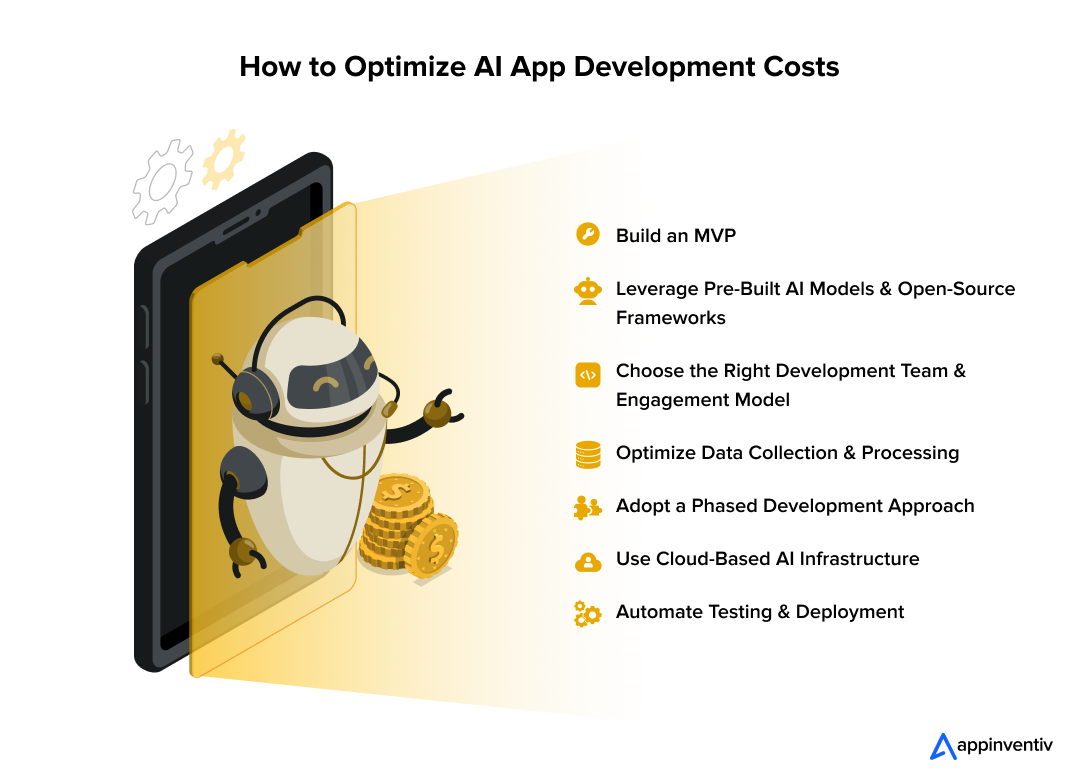
Start with a Clear MVP
Instead of building a full-scale AI app from the start, develop an MVP with essential features. This allows you to test the concept, gather user feedback, and refine the product before investing in advanced AI functionalities.
- Potential Savings: 30%–50% of total development costs
Leverage Pre-Built AI Models & Open-Source Frameworks
Developing AI from scratch can significantly increase the cost to build an AI-powered app in Australia. Instead, use pre-trained models and open-source libraries to reduce development time and expenses.
- Examples of some of the most commonly used tools:
- Google’s BERT for NLP instead of training a custom language model
- OpenCV for computer vision rather than developing new image-processing algorithms
- TensorFlow, PyTorch, and Scikit-learn for machine learning tasks
- Potential Savings: 40%–60% on AI model development
Choose the Right Development Team & Engagement Model
- Build a Hybrid Team: Combine in-house expertise with offshore AI developers to reduce costs without sacrificing quality.
- Outsource Non-Core Development: Work with third-party firms for specific tasks like model training, data annotation, or UI/UX design.
- Consider AIaaS: Instead of building custom AI infrastructure, use platforms like AWS AI, Google Cloud AI, or Azure AI.
- Potential Savings: 25%–50% on operational costs
Optimize Data Collection & Processing
- Use Public Datasets: Instead of collecting data from scratch, leverage publicly available datasets like ImageNet, OpenAI’s GPT datasets, or Kaggle datasets.
- Crowdsourced Data Annotation: Services like Amazon Mechanical Turk or Scale AI can reduce annotation costs.
- Potential Savings: 20%–40% on data preparation
Adopt a Phased Development Approach
Developing AI apps in phases allows businesses to monitor ROI and make adjustments before full-scale deployment.
- Phase 1: Develop and test AI models on a small dataset
- Phase 2: Expand functionality based on real-world performance
- Phase 3: Scale the solution with optimized infrastructure
- Potential Savings: 35%–50% by preventing unnecessary rework
Use Cloud-Based AI Infrastructure
Building on-premise hardware and maintaining in-house AI infrastructure is expensive. Cloud services provide a flexible, pay-as-you-go model that scales with demand.
- Instead of buying high-end GPUs for deep learning, use Google Cloud TPUs or AWS EC2 instances.
- Potential Savings: 50%–70% on infrastructure and operational costs
Automate Testing & Deployment
AI apps require continuous testing and updates. Automated testing frameworks and CI/CD pipelines reduce manual effort, speeding up development and lowering costs.
- Tools: Selenium, TensorFlow Model Analysis, PyTest
- Potential Savings: 20%–30% on development lifecycle costs
Reducing the AI app development cost in Australia doesn’t mean cutting corners – it’s about strategic planning, leveraging existing resources, and making phased investments. By adopting a mix of open-source tools, cloud infrastructure, and outsourced expertise, businesses can build high-quality AI applications without unnecessary financial strain.
Appinventiv’s Approach of Smart Cost Planning Without Compromising AI Excellence
Appinventiv, a trusted AI development firm in Australia, helps businesses navigate the complexities of app costs while delivering cutting-edge solutions. Our approach ensures that every dollar spent translates into scalable, high-performance AI applications. Here’s how we strategically plan and optimize the cost and process of AI-based mobile app development services in Australia:
Defining the AI Scope with Business Goals in Mind
We don’t just build AI apps. We align AI capabilities with business objectives. Our team works closely with you to define the right AI model, level of automation, and expected outcomes, ensuring that every feature is essential and impactful. This helps avoid unnecessary development costs while maximizing value.
Selecting the Right AI Stack for Cost-Effectiveness
Instead of reinventing the wheel, we leverage a mix of pre-built AI models, open-source tools, and proprietary frameworks to accelerate development and reduce costs. For instance:
- We use OpenAI’s GPT models for NLP instead of training a new language model from scratch.
- We opt for cloud-based AI solutions like Google Vertex AI or AWS SageMaker to eliminate heavy infrastructure costs.
- We apply transfer learning techniques, so businesses don’t have to train AI models on vast datasets, reducing computational expenses.
Agile & Phased Development to Reduce Risks and Costs
Our agile methodology ensures that AI apps are developed in iterative phases, allowing businesses to:
- Start with a lean MVP, focusing on core AI features.
- Test AI models on small datasets first before full-scale deployment.
- Optimize development at each stage based on real-world performance, avoiding costly reworks.
Data Strategy That Minimizes Expenses
Data preparation is one of the biggest drivers of the investments you would make in AI-powered app development in Australia. We optimize this by:
- Leveraging existing public datasets where possible to minimize data collection costs.
- Using automated data labeling and annotation tools instead of manual efforts.
- Implementing AI-driven data augmentation to enhance small datasets without excessive investment.
Optimized Deployment to Cut Infrastructure Costs
AI applications require substantial computational power, but we ensure cost efficiency through scalable deployment models:
- Using pay-as-you-go cloud models instead of expensive on-premise setups.
- Deploying AI models as microservices to optimize resource utilization.
- Fine-tuning AI models post-launch to improve performance without increasing operational costs.
Strategic Resourcing for Development
We offer flexible engagement models so businesses can choose between full-scale AI development, consulting, or implementation support based on their budget and needs. Whether it’s an end-to-end solution, AI integration into existing systems, or model training, we ensure businesses invest in exactly what they need – nothing extra.
At Appinventiv, we believe AI innovation shouldn’t come with unsustainable costs. Our tailored cost-planning strategies help businesses build powerful AI solutions while maintaining financial efficiency and keeping up with the future of AI app development in Australia. Whether you’re a startup exploring AI or an enterprise scaling AI-driven operations, we help you achieve high-quality AI development within an optimized budget.
Schedule a consultation call with our experts now.
FAQs
Q. How much does AI app development cost in Australia?
A. The cost of AI app development in Australia varies widely based on technology type, complexity, industry, and development scope. On average:
- Basic AI-powered apps (e.g., chatbots, recommendation engines): AUD 50,000 – AUD 150,000 (~USD 33,000 – USD 100,000)
- Mid-range AI apps (e.g., predictive analytics, NLP-based assistants): AUD 150,000 – AUD 350,000 (~USD 100,000 – USD 230,000)
- Advanced AI solutions (e.g., deep learning, robotics, autonomous systems): AUD 350,000 – AUD 1M+ (~USD 230,000 – USD 670,000+)
Q. How long does it take to develop an AI app in Australia?
A. The development timeline depends on app complexity, data availability, and AI model training requirements:
- Simple AI applications: 3 – 6 months
- Moderate AI-driven platforms: 6 – 12 months
- Complex AI solutions requiring deep learning & custom models: 12+ months
The timeline can be optimized by using pre-trained AI models, cloud infrastructure, and phased development strategies.
Q. What is the future of AI applications in Australia?
A. Australia’s AI market is growing rapidly due to government investments, a skilled workforce, and increased AI adoption across industries. Key trends shaping the future include:
- Greater AI adoption in healthcare, finance, and logistics for automation and predictive insights.
- A rise in ethical AI practices and compliance measures due to Australia’s strong data protection laws.
- Expansion of AI-powered robotics & autonomous technology in industrial sectors.
- Integration of AI with IoT and blockchain for smarter, more secure applications.
Q. How can I optimize costs without compromising quality?
A. To balance cost and quality, businesses can follow the below-listed practices:
- Utilize Open-Source Tools: Incorporate open-source libraries and frameworks to reduce licensing fees.
- Cloud Services: Opt for cloud platforms that offer scalable resources, minimizing infrastructure costs.
- Outsource Strategically: Consider outsourcing specific tasks to specialized professionals or agencies to manage expenses effectively.


- In just 2 mins you will get a response
- Your idea is 100% protected by our Non Disclosure Agreement.

How Much Does It Cost to Build a Car Rental App like Hertz?
Key takeaways: The cost to build a Hertz-like app ranges roughly $40,000–$300,000+. Complexity, automation, and scale matter more than just the number of features. Real costs continue after launch: infra, maintenance, support, and compliance. Smart planning and MVP-first approach help keep budgets under control. Revenue comes from rentals, add-ons, subscriptions, partnerships, and fleet sales. You…
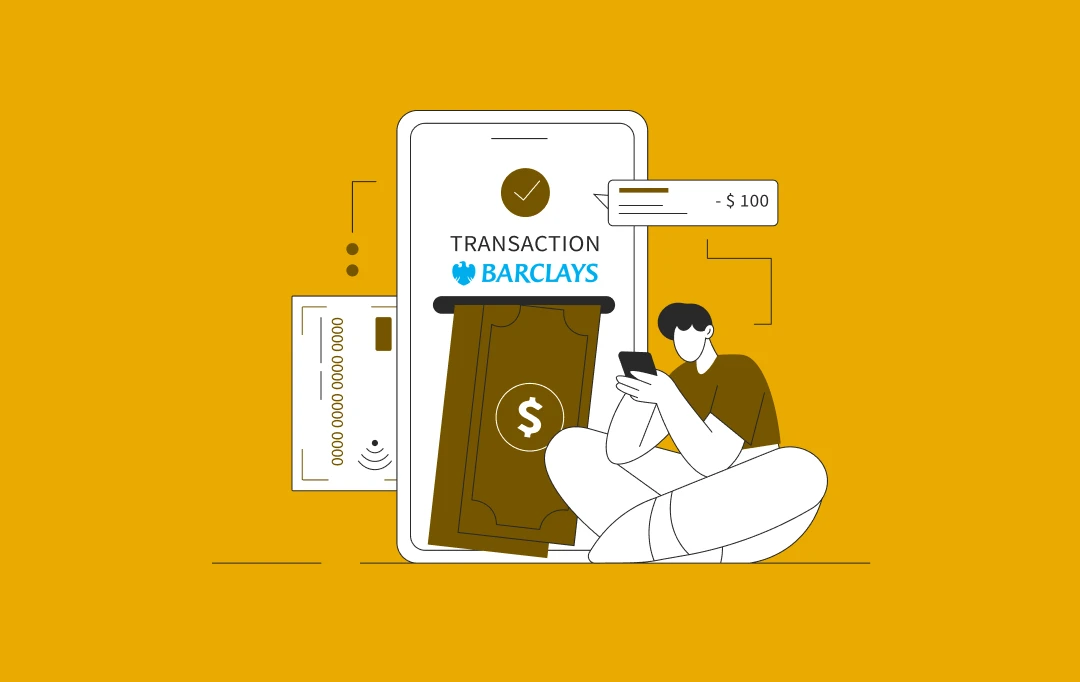
How Much Does It Cost to Build a Banking App like Barclays?
Key takeaways: Barclays sets the bar: Its speed, security, and money management tools show what EU users expect from modern banking apps. Costs vary a lot: A basic, compliant app can start around $40,000 (≈€30,000), while a feature-rich build can reach $400,000+ or more (≈€298,000+). Rules add real work: Meeting PSD2, GDPR, and instant payment…
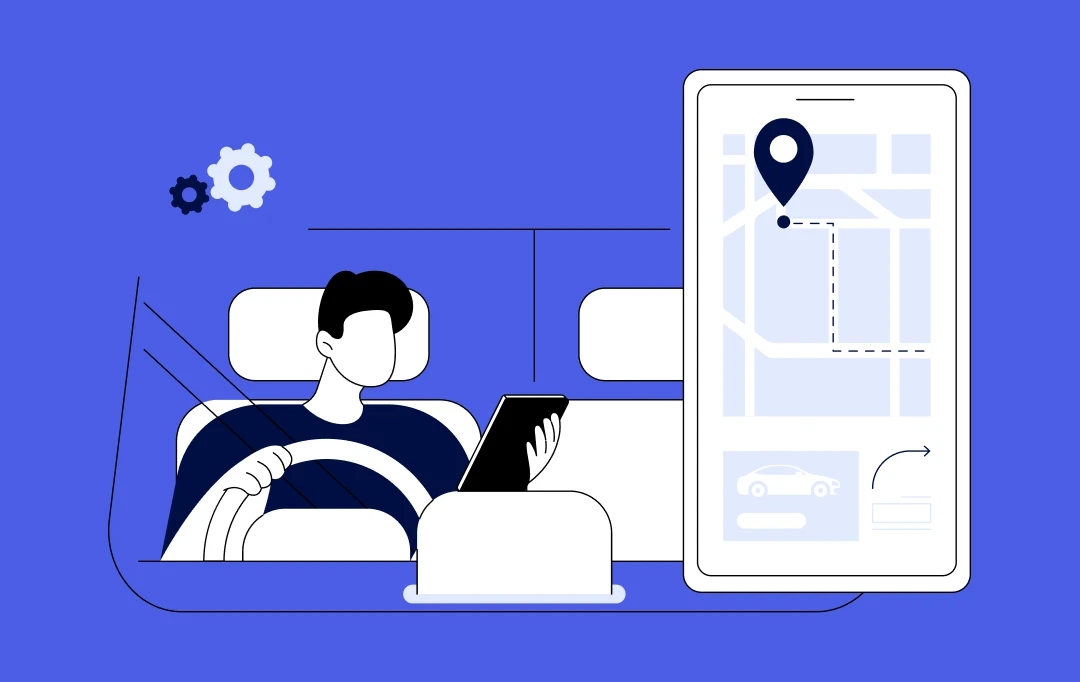
How Much Does It Cost to Build a Route Planning App Like Komoot
Europe doesn’t just love the outdoors- it thrives on it. From the Alps to Amsterdam’s bike lanes, cycling and hiking fuel an industry worth $53.3 billion in 2024, projected to grow at nearly 11% CAGR through 2033, as reported by GrandViewResearch. And leading this charge is Komoot, the route-planning app trusted by 40+ million users.…
